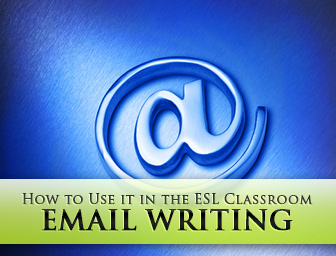Press Here To Send: 13 Ways To Use Email in Your ESL classroom


Far and wide, it has become the medium of communication of choice, which is why it is also a great medium for English learners. It is real, it is fast and the skills they learn will be of use to them now or in the near future. Not convinced yet? Let’s look at the advantages of using email writing in the ESL classroom.

Email writing is the ideal type of homework assignment. Students may compose and send email from the comfort of their own home. Or coffee shop. Any time, any day. It’s the perfect “excuse” to extend the time students spend writing in English outside the classroom.
Email writing provides ESL students with the chance to write in a real-life context, and if they’re not currently writing emails in English, they will most likely have to in the future. You should provide them with practice in this authentic setting, where they will also have the benefit of corrections.
When students write emails to each other, the teacher is no longer at the center. They decide when to write and how to write the email – the goal is communication. The teacher is there to guide students and help in case of doubt.
You may choose to review topics covered in class via email writing, or tell students they can choose any topic they want to write about. You can make the assignment as targeted or as open as you please.
It’s super fast and easy for students to send emails. And also a great paperless activity. Moreover, it’s the ideal way to connect with and write to people in foreign countries.

This is a less student-centered approach, but something you can do with students of all levels and adapt to suit their needs. Write a simple email with a greeting and a simple question. Each student must reply by answering your question and adding their own question at the end. Which you will answer in your reply. Communication can go on like this for as long as you like. For more advanced learners, you may give them something more complex to reply to like a creative writing prompt.
Divide students into pairs and tell them they must write to each other, all the while cc’ing you. You can either give them a specific topic related to what you did in class (write to each other about what you did over the holidays) or tell them they can choose.
This is a little more complex, but you can definitely make it work. Give your class (or divide it into smaller groups) something they must research, for example a country. They must decide who will search for local foods, who will search for customs, who will search for statistics, etc… Students communicate their findings to the group, all the while cc’ing you. At the end, they must create a Word doc about the country they researched to send to you.
Give your class a printed copy of the class mailing list. Send the first student on the list an email with the beginning of a story: It was a dark, stormy night when Sarah heard a noise downstairs. The student must add one sentence to yours and email it to the next student on the list. And so the chain continues with each student adding their own sentence till the story is finished. Don’t forget to tell them to cc you for each reply.
Send your students an email and tell them it has 7-8 mistakes they must find and correct. They must reply with the correct version.
Send students an email in which the greeting, closing and paragraphs are in the wrong order. Students must cut and paste the parts, compose the message correctly and send it back to you.
Send to your class an email with blanks they must fill in. Be sure to include key parts of the email as blanks, such as the greeting and closing, or words that make the email more or less formal.

Send your Business English students a business-related inquiry they must reply to: the cost of their service, questions about their products, if they may forward a copy of their catalog, etc… Students must reply and use their knowledge of appropriate business communication.
Did you notice something here? You can take any writing assignment you’d ordinarily make your students write in class, and assign it as email. It’s eco-friendly, efficient and you’ll be helping them develop the writing skills they’ll need in the future.
Leave your comments below!